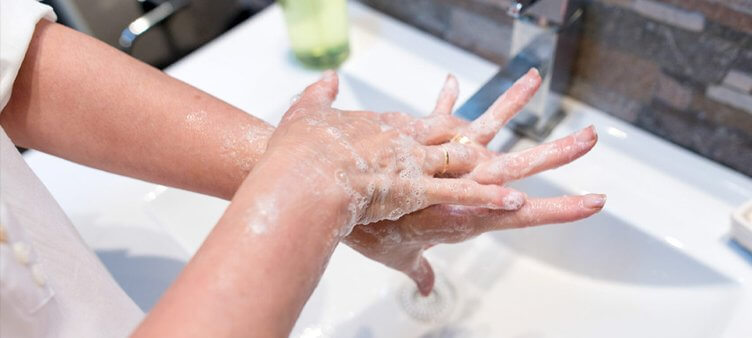
During the ongoing coronavirus pandemic, cleaning your hands regularly and correctly is essential not just for your own health and wellbeing, but everyone else’s too. According to the World Health Organization (WHO), everyone should regularly and thoroughly clean their hands with soap and water, or if that is not available, an alcohol-based hand sanitiser (or certain alcohol-free ones).
This is because regular handwashing and hand sanitation clean viruses that may be on your hands, helping to protect against infection and stop you from contaminating other surfaces. Even when your hands are not physically dirty, they can still be contaminated. Think about all the shared surfaces you touch on a daily basis and all the other people who will have done the same… exactly!
According to the World Health Organisation, however, when hands are washed and sanitised properly, it can be over 90 per cent effective at preventing the spread of harmful germs.
Unfortunately, a large number of people are unaware that they’re not washing their hands properly. In doing so, they’re missing key areas like the thumbs and fingertips.
Numerous studies have covered the correct handwashing method, and the World Health Organisation has official guidance on the same in the form of a 6-step technique which ensures that hands are thoroughly cleaned.

The World Health Organisation’s 6-step handwashing process. Although there are 11 steps above, steps 2—7 are the handwashing steps. Image credit: Global News CA.
As you can see, the technique used really does matter. If you’re going to wash your hands, you should follow the WHO’s 6-step process which is relevant to everyone, not just people working in healthcare sectors.
After all, what’s the point in cleaning your hands if you’re not going to do it properly? The key defence against many respiratory illnesses, including COVID-19 is good hand hygiene. However, you must ensure all parts of your hands are clean to maximise protection. Memorising the 6-step technique is not easy, but it is achievable with practice over time.
It’s not uncommon to hear complaints that the 6-step WHO technique is too difficult and complex to learn. However, there really isn’t much to it; if you can drive a car or ride a bike you can learn to wash your hands properly.
Hand hygiene is one of the most important practices to help prevent the spread of illnesses and diseases. Despite its importance, however, lots of people neglect to wash their hands properly… or at all! In light of the importance of hand hygiene during the COVID-19 outbreak, we need to make a much more conscious effort when cleaning our hands throughout the day.
Alcohol-based hand sanitiser is simple to use, easy to access, and convenient. While there’s a correct way to use it for the best results, what’s more important is knowing when using it is might not be the right choice. Hand sanitiser does kill microbes on your hands, however, it isn’t effective on all germs and does nothing for other substances that might be on them.
That’s why health authorities always recommend cleaning your hands with soap and water whenever possible, as often as possible (and always when your hands are visibly dirty!)
However, it’s no secret that handwashing with soap and water isn’t always possible due to the absence of access to handwashing facilities. In this case, it’s recommended that you use an alcohol-based hand sanitiser. While this does not clean the hands, it does kill viruses and bacteria that might be on them, just like soap and water does.
When hand sanitiser first came out, there was very little research showing what they did and didn’t do, but that has changed. And while more research needs to be done, scientists are learning more all the time.
The active ingredient in most hand sanitisers is isopropyl alcohol (rubbing alcohol) or a similar form of alcohol such as ethanol. Occasionally, a hand sanitiser may have a combination of them. For a long time, scientists have known that alcohols kill microbes by dissolving their outer layers of proteins and disrupting their metabolism.
Hand sanitisers don’t kill every type of germ and virus, however, such as norovirus and cryptosporidium. In contrast, soap and water do.
The U.S. Centers for Disease Control recommends hand sanitisers with at least 60 per cent alcohol content. Most products contain between 60% and 95%, but don’t assume that the higher the percentages are more effective. To work at peak efficiency, these products also need to contain some water.
If you’re somebody who has sensitive skin, for example, you might benefit from an alcohol hand sanitiser with lower alcohol content and added ingredients that soothe the skin.
For hand sanitisers to be effective, they need to be used properly. Their effectiveness is based on factors like how much of it you’re using, whether you’re using the proper technique, and the right timing.
When using hand sanitiser, make sure you follow this approach:
Quantity: When you are using hand sanitiser, you need to apply it in the right way. Use enough hand sanitiser so that the liquid or gel coats every part of your hands, including the backs of your hands, the area just above your wrist, and your fingernails.
Method: Hand sanitisers must be thoroughly rubbed into the hands so that no residue is left, and that the solution has completely evaporated. Make sure that you continue to rub it in until your hands dry off. Don’t start touching things with sanitiser-soaked hands and don’t wipe it on your clothes.
Timing: Sanitisers are designed to kill microbes. They’re ideal for use at the right time, such as when you’ve just shaken somebody’s hand, rode the bus, or touched something that other members of the public have touched, too. Don’t use hand sanitiser when your hands are visibly dirty or when you’re able to use soap and water.
Not many people know that alcohol-free hand sanitiser exists, but it does! It’s not as common as alcohol-based hand sanitiser, but it’s there for people who need an alcohol-free alternative due to things like religious beliefs and skin sensitivities.
Alcohol-free hand sanitisers, like Nilaqua hand sanitiser, works in exactly the same way as alcohol-based hand sanitiser. The only difference is the active ingredient that’s used: Instead of alcohol, it’s something totally different like benzalkonium chloride, a cationic surfactant.
In the fight against coronavirus, you should be washing your hands and regularly using hand sanitiser. This is the best way to make sure that your hands are totally clean and pose a lower risk of passing germs on to somebody who could suffer as a result.
Wash your hands at every chance you get (and definitely each time you visit a bathroom!) and ‘top-up’ with hand sanitiser every so often as necessary, such as when you’ve shaken someone’s hand, touched an animal, opened a door, or touched a trolley.
Here at Hand Sanitiser Station, we sell our own range of alcohol-based hand sanitiser dispenser and automatic hands-free hand sanitiser dispensers. We’ve also got alcohol-free hand sanitisers from Nilaqua for those who require them.
If you’d like to find out more about our product offerings, visit our shop or contact us.
Emir Limam – E11 Group B.V. Netherlands – Fraudster
24 May 2023When to Take a Test After Covid Exposure?
30 January 2023A Rapid Antigen Test vs a Lateral Flow Test for Covid-19
30 January 2023